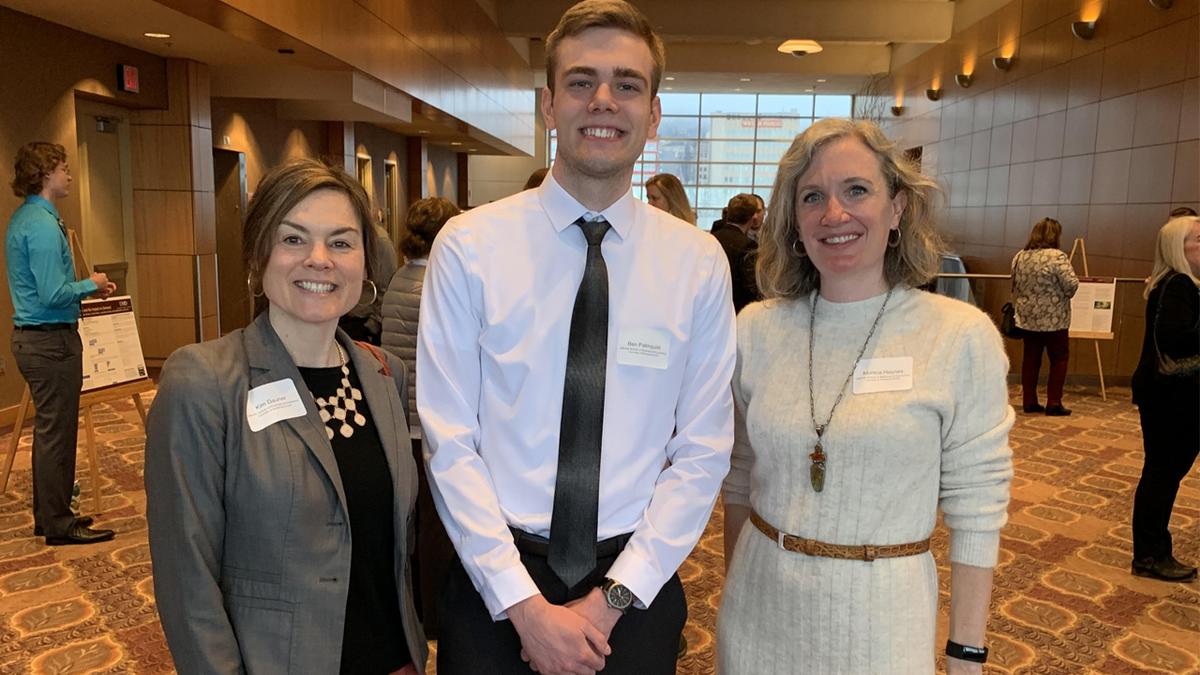Photo: Associate Professor of Economics and Co-Director of Health Care Management Kim Dauner, Bureau of Business and Economic Research (BBER) Undergraduate Research Assistant Ben Palmquist, and BBER Director Monica Haynes at the Student Poster Session.
Here are a few highlights of the April 5 event in case you weren’t able to attend.
Insights from the Federal Reserve Keynote speaker, Ron Wirtz, Minneapolis Federal Reserve director of regional outreach, knocked it out of the park with his VERY thorough and informative presentation on Duluth’s regional economy. Some of his key points were:
- Construction activity in the region has been exceptionally strong in recent years, in large part due to the Vision Northland project but also from residential remodeling activity and multi-family construction projects.
- The residential real estate market is experiencing strong demand, low inventories, and high prices. This mirrors the trend in Minnesota and nationwide.
- Regional shipping rebounded in 2021, thanks to increases in the price of taconite.
- The tourism industry in Northeast Minnesota is mostly recovered from the impacts of COVID and is a bright spot in the state.
- Inflation and staffing shortages continue to be major challenges for local businesses and consumers, and now, the Ukraine crisis looms large as well.
But one of the main points of Wirtz’s presentation was that the labor market tightness that has become increasingly challenging for businesses is not new—in fact, it first began in the early 2000s—and it will likely persist for many years to come. According to Wirtz, the only way to address the labor shortage is to address some of the obstacles faced by job seekers, including those challenges related to the economic environment and government policy (e.g. childcare, housing, transportation). He also noted that in this new environment, in which workers have more leverage, there is a need to shift the mindset that workers are “lucky to have a job,” which came out of decades of a labor surplus environment.
Bureau of Business and Economic Research (BBER) student presentation From the BBER standpoint, one of the highlights of the morning was seeing Ben Palmquist, BBER undergraduate research assistant, present the findings of his research on the regional economy. Palmquist presented on the region’s unemployment rate, labor force participation, gross domestic product (GDP), and industry performance in the 15-county region since the start of the COVID-19 pandemic. According to Palmquist’s research, unemployment rates have mostly returned to normal since the pandemic, dipping to levels below 3.0% in late 2021, but Minnesota’s labor force participation has seen a marked decline since June 2020. While few of the region’s industries had returned to their 2019 or pre-pandemic employment levels by the end of 2021, nearly all saw employment growth from 2020 to 2021. The leisure and hospitality, mining, and professional and business services sectors saw the largest relative increases in employment during the period.
University partnerships One of the amazing things about the REIF is that it represents nearly ten years of partnership between the three local universities—the University of Minnesota Duluth, the University of Wisconsin Superior (UWS) and the College of St. Scholastica (CSS)—and showcases the students’ research that benefits the REIF communities. Along with Palmquist from UMD, Grant Garding from UWS, Augusto Vladusic also from UWS, and Omar Bensouda from CSS presented research on the economic performance of the REIF region. Supporting the presenters were eighteen other student researchers from the universities. The research is also available in a digital brochure (compiled and edited by the BBER). It was a pleasure to be able to hear other research team’s findings on the current economic state of the REIF region, and as Ron Wirtz said, the student presentations were a great introduction to his presentation, “not too much difference between the junior varsity and varsity teams.”
Student Poster Session Part of every in-person spring REIF is the Student Poster Showcase whereby students from the three universities of UMD, UWS, and CSS share their high-level research projects via posters. REIF attendees are invited to visit with these student researchers prior to the speakers’ presentations to hear not only about the research projects and their outcomes but also how the work that went into the research projects will help the students in their careers
LSBE students were on hand to showcase six posters featuring the following topics:
- A Guide to Environmental, Social, and Governance investing (Benjamin Pratt)
- Looking a Resilience with a New Eye: A nomological Network and Model (Abbey Sweetman)
- Effects of Minimum Wage Increases on Poverty (Aidan Kray)
- The Misuse, Abuse, and Over-prescription of Opioids (Anna Burggraff, Grace Henriksen, Maddie Moore, and Jacob Wojtowicz)
- Supply Chain Disturbances and the Impact on Demand (Alix Anderson, Renee Boldus, Brandon Fredricksen, Jonathan Hofmann, Esther Maier, and Jacqueline Olander)
- Summer 2021 Actuarial Internship Portfolio (Tyler Henkemeyer)
In-person gatherings After two years of hosting REIF events virtually, it was such a pleasure to be back in person for this event. Networking with students, business owners, and the business community is something that you just can’t get in a virtual environment. Plus, seeing through the banquet hall windows the U.S. Coast Guard’s new cutter Spar docked in the Duluth harbor and the sun rise over the Aerial Lift Bridge during Wirtz’s presentation was much more pleasant than sitting in front of a laptop. The plated breakfast including sugarcoated waffles was a nice treat as well!
